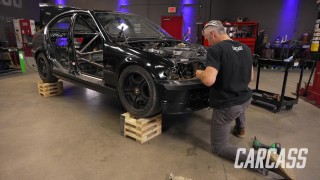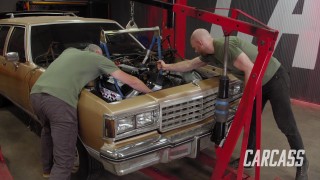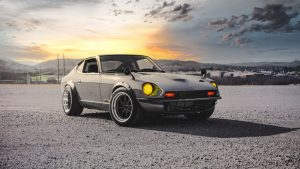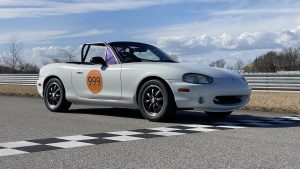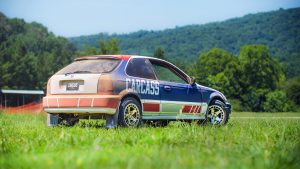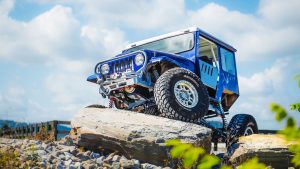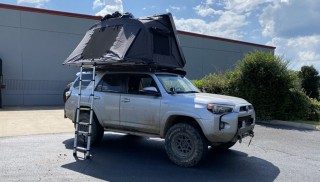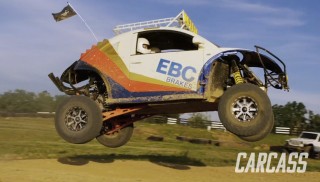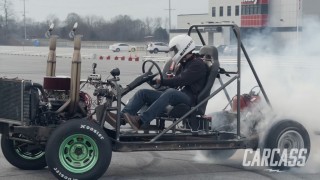Carcass Featured Projects
Carcass Builds
Want more content like this?
Join the PowerNation Email NewsletterParts Used In This Episode
Edwards Ironworkers
Edwards Ironworker & Horizontal Press
Matco Tools
MATCO Tools are the Official Tool Supplier to PowerNation
The Industrial Depot
Tools, Hardware, Shop Supplies
Episode Transcript
(Jeremy)>> You're watching Powernation!
(Jeremy)>> Today on Carcass we introduce a ridiculously huge project vehicle.
(Jimmy)>> And before we even touch it we're taking it off road.
(Jeremy)>> You're watching Carcass. [ MUSIC ]
(Narrator)>> When you want to build something different you turn to Carcass. They transform cars and trucks into one of a kind builds. From street to mud, if you dream it they can build it. This is Carcass, a non-traditional speed shop. [ MUSIC ]
(Jimmy)>> This behind me is our 1984 Chevy M1010 ex-military truck. Now this thing was used as an ambulance for the US Coast Guard.
(Jeremy)>> So the bones are the truck are really what we're the most interested in. It's got a Corporate 14 underneath the rear. It's got a Dana 60 on the front of it, which is the kingpin style that everybody's looking for. It's got an old, tired clapped out 6.2 diesel underneath the hood, which is definitely gonna go, but it's got a big turbo 400 and a 208 transfer case, and that is gonna be the best platform we can get to build, well something really really crazy. [ MUSIC ]
(Jeremy)>> Well Jimmy what do you think? Take this thing off road?
(Jimmy)>> I think so. It's very underpowered, extremely overweight, and has an astronomically high center of gravity. So what could go wrong? [ MUSIC ]
(Jeremy)>> The truck's been doing absolutely outstanding. You really can't ask for a better base platform to start with, and it's locked already.
(Jimmy)>> What else do you want I guess?
(Jeremy)>> We upgraded, we threw some tires on it.
(Jimmy)>> Threw some tires on it, necessary.
(Jeremy)>> Necessary upgrade.
(Jimmy)>> The skinny 235's weren't gonna do us much good in the mud holes but these 37's, they got it.
(Jeremy)>> We're having a blast driving our new project vehicle around at Wooly's Off Road Park.
(Jimmy)>> And since it recently rained we're having a whole lot more fun.
(Jeremy)>> With our daylight quickly fading we decided to end our day of fun.
(Jimmy)>> We had a great day of wheeling and all we have to do now is get our truck back to the shop and start our project. [ MUSIC ]
(Jimmy)>> Oh this was a genius idea.
(Jeremy)>> Man I don't know about you but I am super excited about this combo.
(Jimmy)>> Me too but it's a lot of work until we get to see the final product. We have huge plans for this truck and it all revolves around our 1953 Willys body and the chassis of our 1984 CUCV, and to top it all off we're gonna throw a blown small block Chevy at it.
(Jeremy)>> To do all that we're gonna have to drastically change the way our CUCV looks to accommodate the Willys body, and that means we're gonna have to shorten the chassis, but before we can even think about doing that we're gonna have to get rid of the cab and that big 2,000 pound box that's on the back.
(Jimmy)>> Alright let's see what we're working with here.
(Jeremy)>> Well it's just like a regular truck bed ain't it?
(Jimmy)>> It looks like there's brackets welded to the chassis and then bolted to the box.
(Jeremy)>> Alright so should we use the torch or try the impact?
(Jimmy)>> I think a combo of both would be fine.
(Jeremy)>> Alrighty, well now's a good time to start. [ MUSIC ] With getting rid of this massive box there's some stuff that's pretty easy, and then there's some stuff that's gonna need some real persuasion. [ MUSIC ]
(Jimmy)>> Alright man how do you think we're gonna pick this up?
(Jeremy)>> Well I think the front corner should be plenty strong right here.
(Jimmy)>> Yeah it's pretty thick. I think that'll work.
(Jeremy)>> And then I think we'll pick right off the back kinda the same spot.
(Jimmy)>> Okay, I'm down with that.
(Jeremy)>> Alrighty. [ mechanical humming ]
(Jeremy)>> Okay I think we're good. We can roll out of here.
(Jimmy)>> Alright let's push it.
(Jeremy)>> With the front end of the truck out of the way we'll use a cart to get rid of the box. That will make room for us to get started on our front end because we're gonna need the lift to help disrobe this beefy chassis. With everything taken care of under the hood we can tackle the body mounts. [ MUSIC ]
(Jimmy)>> We're gonna attack all these items simultaneously and removing the grille guard will help us do just that.
(Jeremy)>> That's heavy duty. Draining the fuel will allow us to snip the lines right next to the gas tank, and then we can start the process of removing that old thing.
(Jimmy)>> We'll hop on the exhaust next. There's really no point in keeping it around because we're shortening the frame and we're going with a different engine.
(Jeremy)>> There's a few more points we need to disconnect before we can get to the heavy lifting. The front driveshaft needs to come loose, and then we'll just heat up the rear bolts so we can get that loose as well. After a quick wash we slice and dice our frame to accept our Willys body next on Carcass.
(Jeremy)>> Man that pressure washer worked great. This thing's squeaky clean.
(Jimmy)>> Now we've got to figure out how to get that onto this chassis.
(Jeremy)>> The wheel base of our CUCV is 132 inches. Now the wheel base of our Willys is 104 inches. Now to marry those two together we're gonna have to cut a section out of the frame of the CUCV. When we're done with that we're just gonna bring the two halves together. Then we'll grab our Willys body and set it right on top.
(Jimmy)>> To get this cutting party started we opted to use cutoff wheels. The cutting disc makes it pretty easy to follow a straight line.
(Jeremy)>> To knock this out fairly quickly Jimmy and I are both gonna be cutting each side of the frame. We're gonna cut the front side loose first, but this isn't gonna be just any old straight cut.
(Jimmy)>> That's right. At the bottom of our frame we left a little tab, and this will help realign the chassis later on.
(Jeremy)>> With our final cut releasing some stress in the frame we'll separate the two halves.
(Jimmy)>> Half way done. Half the truck, get it? Yeah! With the front half out of the way we'll get started shortening the chassis. In this scenario we're starting at the bottom. We'll follow that up with cutting up the side of the chassis, and finally we'll make the last cut safely from the top, allowing the 25 pound chunk of metal to fall to the ground.
(Jeremy)>> Lastly we'll sneak up on our lines with a grinder. Then we'll prep the two sections to be welded back together. This is a good time to wear your respirator with all that metal and rust that's in the air. [ MUSIC ] Wow, that's a whole lot lighter than I expected it to be.
(Jimmy)>> I'm hoping this fits up but I'm expecting we'll have to do a little bit of trimming before we can tack it up.
(Jeremy)>> It kinda looks like the chassis widened when we cut it apart.
(Jimmy)>> We can take a ratchet strap, loop it around, and then see if we can't get it back in alignment.
(Jeremy)>> Yeah we'll pull them together before we tack it.
(Jimmy)>> Good idea! [ MUSIC ] [ ratchet clicking ] [ welder crackling ]
(Jeremy)>> Alright my side's tacked and you're tacked too right?
(Jimmy)>> Yeah but the bottom of the frame rail is still kicked out about a sixteenth on my side.
(Jeremy)>> I'm out like three-sixteenths on my side.
(Jimmy)>> So I think we keep tightening the ratchet strap until my side comes in. I'll tack it, tighten it more, tack your side.
(Jeremy)>> That's a fantastic plan, let's do that.
(Jimmy)>> That's good.
(Jeremy)>> We're making sure to add some beefy tacks because we're adding a lot of stress with the ratchet strap. Each click of the strap adds more force to the chassis. A small tack could easily crack and cause a dangerous situation. [ welder crackling ]
(Jimmy)>> All tacked up?
(Jeremy)>> All tacked up over here.
(Jimmy)>> Alright let's get this thing welded in. [ welder crackling ]
(Jimmy)>> And to make sure that we have good weld penetration we added a bevel to each side of the frame rail, resulting in a strong weld.
(Jeremy)>> We have the chassis welded now but to make sure it's strong enough we're gonna add some reinforcement in what's called a fish plate.
(Jimmy)>> A fish plate is just a fancy name for a plate that bridges the weld seam in the chassis. This gives us another layer of reinforcement and ultimately adds more strength. We're making our fish plate out of eighth inch steel. Installing this sturdy plate is fairly easy. A couple of tacks to hold it in place. Then all you do is burn it in. [ welder crackling ]
(Jeremy)>> But we're not gonna stop here. A common way to reinforce the frame is to box it in. Boxing the frame increases its rigidity and adds yet another layer of reinforcement that will brace the seam. When doing work like this my first step is to always make a template. Then the template will be traced out of eighth inch plate steel. [ torch hissing ]
(Jeremy)>> With a quick test fit, perfect, and a couple of tacks... [ welder crackling ]
(Jeremy)>> ...we can both get to work welding these in. Now we're not gonna weld these in solid in one shot. We're gonna end up moving around to help disperse the heat that we pile into the chassis. This will mitigate any weld distortion and keep our frame true and as close to stock strength as possible. All the body mounts are riveted to the frame, and there's a number of ways we can remove them. We're going with a grinding method.
(Jimmy)>> We're gonna grind down the head of each rivet flush with the bracket. Then with a punch and hammer will knock each one out.
(Jeremy)>> Each body mount has about five rivets. So this may take a while, but getting rid of these will make it a whole lot easier to set the Willys body on top of the chassis. [ MUSIC ] Oh yeah, I think we need to roll the chassis forward. [ MUSIC ] Alright let's try that.
(Jimmy)>> Alright going down. Coming up it's official. We marry the Willys to our M-10-10 and start our Dana 60 refresh.
(Jeremy)>> Keep going. Okay stop right there.
(Jimmy)>> It actually looks really level the way it's sitting there now.
(Jeremy)>> You're right. That's sitting like perfectly level on the chassis.
(Jimmy)>> So I think we just make mounts as it's sitting there and call it good.
(Jeremy)>> Yeah we'll just leave it right there.
(Jimmy)>> This all starts with cutting a three inch section of four by two rectangular tubing. [ welder crackling ]
(Jimmy)>> With the bushing out of the way we can make this body mount permanent. [ welder crackling ]
(Jeremy)>> We need to create a number of body mounts for this body swap. Seven of them to be exact, and all of them have their own set of challenges. With this specific one we're using the stock body mount on the Willys. So we'll have to build a matching chassis mount to marry the two together. With the template traced out on an eighth inch plate of steel we can move over to the Edwards Iron Worker and cut them out. With two of the three pieces we need already cut out all there's left to do is to assemble our triangular mount. The first plate is eyeballed into position and then just tacked in place. The second is eyeballed in a similar fashion and tacked in as well. The reason we can eyeball these is because we're gonna cut the top plate to fit. We'll use our trusty Edwards Iron Worker to cut out the shape and just punch a hole for the bolt. Then we can just slide in our top plate and our bushing for a quick test fit. Perfect! Knowing we have a good fit, the top plate gets tacked into place. [ welder crackling ] [ mechanical humming ] [ welder crackling ]
(Jimmy)>> It's now time as some would say to lock in this marriage, and we're gonna make this match final with a few bolts, a few washers, and some torqued down nuts.
(Jeremy)>> Our huge CUCV chassis and our iconic Willys body are now one in Carcass matrimony.
(Jimmy)>> Probably cut these wires that are gonna be coming out of here. We're gonna take out all the interior for two reasons. One, we need to get rid of that chicken wire firewall and two, this truck is gonna spend a lot of time in the mud and carpet is just a bad idea.
(Jeremy)>> Wow!
(Jimmy)>> I'd just get cutting away. Just redo this whole thing ourselves.
(Jeremy)>> Alright wiring's pretty much done. Next is kinda the seats huh?
(Jimmy)>> Yeah looks like it.
(Jeremy)>> I have no idea how they come out of here though. Look at that. Dude there's like a little trap door down here.
(Jimmy)>> Oh yeah, you're right.
(Jeremy)>> And then the seats are just bolted right down to this riser. Well that's easy enough. [ MUSIC ] There's one!
(Jimmy)>> With the second seat out of the way we can get to tearing out that carpet and remove the steering.
(Jeremy)>> With the interior out and in the dumpster it's time to start on the firewall. We're using reciprocating saws for this job because let's face it. They cut fast and we are not at all concerned about accuracy.
(Jimmy)>> We have a lot of metal to cut through, not to mention the layers upon layers of weld, bondo, and chicken wire. [ MUSIC ]
(Jeremy)>> To free our Dana 60 from the chassis we'll have to unbolt a number of items, including the shocks, the drag link, and the U-bolts that hold everything together. [ MUSIC ] Looking good so far. A little bit, done!
(Jimmy)>> With our axle positioned so it's easy to work on we'll remove the wheels and tires. [ drill humming ]
(Jimmy)>> Then we'll remove the hub and rotor assemblies and pull the axle shafts.
(Jeremy)>> We'll unzip the bolts from the diff cover and pop it open. Once the gear oil drains from the case we'll remove the bearing caps... [ MUSIC ] ...and carefully pry this heavy differential from its snug little home.
(Jimmy)>> We'll take the diff over to the work bench and remove all the ring gear bolts. Then we'll tap it with a hammer doing our best not to let it come crashing down and potentially chipping a tooth.
(Jeremy)>> Up next, we lock it up, raise it up, strap it up, and roll it up.
[ MUSIC ] [ drill humming ]
(Jimmy)>> Since we're dealing with an electronic locker we need to drill a hole in the housing for the wiring. These bearing caps are getting a little heavy man. With the correct shim arrangement we can drop in our new differential and tap it into place. Then we'll secure it with bearing caps and check the backlash.
(Jeremy)>> Finally we can thread the E-locker wiring through the hole that we drilled and make the proper connections.
(Jimmy)>> All in all this only took us a few hours to do, making it an easy swap for a selectable locking front end. [ drill humming ]
(Jimmy)>> The lift in the rear comes mainly from the leaf springs but the BDS provided lift blocks help level everything out. These are sandwiched between the axle and the springs with U-bolts. You want these to be tight. So we torqued these down to 100 pound feet.
(Jeremy)>> We are almost finished with the lift kit in the rear, but before we can move on to the front we're gonna add some shocks.
(Jimmy)>> The front lift kit installs a lot like the rear. The first parts to be installed are the leaf springs. [ drill humming ]
(Jeremy)>> Before we can mount the axle under our chassis we need to add some steering stabilizers. The provided bracket allows us to line them up. Secure them with a bolt and then we'll just snug them down.
(Jimmy)>> The other end is secured to the tie rod bar, and then we check to make sure we have full range of steering.
(Jeremy)>> Now we can finally get our front axle into position. We'll lower the chassis, snug up the U-bolts, securing everything in place.
(Jimmy)>> We'll attach the provided extension bracket to the sway bar. Then attach it to the U-bolt plate and tighten it down.
(Jeremy)>> The last thing we'll throw at our new suspension setup is a pair of shocks... [ drill humming ]
(Jeremy)>> ...completing our 8 inch lift.
(Jimmy)>> Before we get started installing the fuel cell we're gonna take off the tailgate because it's just huge and in the way. Now somewhere along the line someone decided to bolt and weld the tailgate on. So we're gonna cut the welds, unbolt this thing, and set it off to the side. Let's get this guy out of here. [ MUSIC ]
(Jeremy)>> With the tailgate out of the way we can get straight to work cutting the hole in the floor for the gas tank. We're mounting our fuel tank behind the wheel wells and inside the cab.
(Jimmy)>> Our tank has a low spot or a sump for the fuel outlet and return lines. So we need to cut a hole big enough to fit that portion of the tank and any fuel lines we secure to it. [ saw buzzing ]
(Jeremy)>> With our tank in place we can measure for the fuel tank straps. Nine, 17. [ mechanical humming ]
(Jimmy)>> The fuel tank straps can then have four 90 degree bends put in them. Two on the outside for a mounting flange, and then two in the opposite direction to wrap around the fuel tank. Back at the body we'll lay the tank straps down and mark the holes where they'll drilled in the body. [ drill humming ]
(Jeremy)>> We'll add some grade eight hardware and make this a permanent part of the Willys. [ MUSIC ]
(Jeremy)>> A roll cage is the next logical addition for this build. [ MUSIC ]
(Jimmy)>> This style of roll cage doesn't tie into the chassis like others that we've built. Seven by four. This go around the cage is going to be tied into the Willys' floor. The floor isn't as heavy gauge steel as a chassis would be. So we're gonna make large plates to disperse any load that the cage might put into it.
(Jeremy)>> With the steel plates cut out we can prep the Willys body and... [ welder crackling ]
(Jeremy)>> ...tack them in place. Then we can move over to the main hoop, move that into position... [ welder crackling ]
(Jeremy)>> ...and tack that in as well.
(Jimmy)>> With the same tubing material the side hoops are 84 inches long with a 75 degree bend. Then we notch it to fit in with the main hoop, and then attach it to the floor of the Willys.
(Jeremy)>> With our main and side hoops in position we can burn them in. Then we'll measure for a diagonal brace, notch it, and add it to our roll cage for some strength.
(Jimmy)>> To add the radiator out back we're gonna utilize the roll cage we just built to support it. We'll start by getting a quick measurement and cutting out some tubing at the chop saw. Then we'll add a notch at either end, set them in place, and tie them into the roll cage.
(Jeremy)>> At the break we need to bend a strip of aluminum to create the brackets for our radiator. We'll bend these to a nice and simple 90 degrees.
(Jimmy)>> With two brackets in hand we'll use our tig welder to attach our new brackets.
(Jeremy)>> We need to then line the assembly up with the tubing on our roll cage, drill some holes, and then just add some hardware. With the lift kit and the locker in this thing it's definitely bigger and badder.
(Jimmy)>> We got the fuel cell in, just installed the radiator. So we have everything we need to drop in the powertrain, and next time get it started.
(Jeremy)>> Want to see more keep up with this build and all of its updates at Powernation TV dot com.
Show Full Transcript
(Jeremy)>> Today on Carcass we introduce a ridiculously huge project vehicle.
(Jimmy)>> And before we even touch it we're taking it off road.
(Jeremy)>> You're watching Carcass. [ MUSIC ]
(Narrator)>> When you want to build something different you turn to Carcass. They transform cars and trucks into one of a kind builds. From street to mud, if you dream it they can build it. This is Carcass, a non-traditional speed shop. [ MUSIC ]
(Jimmy)>> This behind me is our 1984 Chevy M1010 ex-military truck. Now this thing was used as an ambulance for the US Coast Guard.
(Jeremy)>> So the bones are the truck are really what we're the most interested in. It's got a Corporate 14 underneath the rear. It's got a Dana 60 on the front of it, which is the kingpin style that everybody's looking for. It's got an old, tired clapped out 6.2 diesel underneath the hood, which is definitely gonna go, but it's got a big turbo 400 and a 208 transfer case, and that is gonna be the best platform we can get to build, well something really really crazy. [ MUSIC ]
(Jeremy)>> Well Jimmy what do you think? Take this thing off road?
(Jimmy)>> I think so. It's very underpowered, extremely overweight, and has an astronomically high center of gravity. So what could go wrong? [ MUSIC ]
(Jeremy)>> The truck's been doing absolutely outstanding. You really can't ask for a better base platform to start with, and it's locked already.
(Jimmy)>> What else do you want I guess?
(Jeremy)>> We upgraded, we threw some tires on it.
(Jimmy)>> Threw some tires on it, necessary.
(Jeremy)>> Necessary upgrade.
(Jimmy)>> The skinny 235's weren't gonna do us much good in the mud holes but these 37's, they got it.
(Jeremy)>> We're having a blast driving our new project vehicle around at Wooly's Off Road Park.
(Jimmy)>> And since it recently rained we're having a whole lot more fun.
(Jeremy)>> With our daylight quickly fading we decided to end our day of fun.
(Jimmy)>> We had a great day of wheeling and all we have to do now is get our truck back to the shop and start our project. [ MUSIC ]
(Jimmy)>> Oh this was a genius idea.
(Jeremy)>> Man I don't know about you but I am super excited about this combo.
(Jimmy)>> Me too but it's a lot of work until we get to see the final product. We have huge plans for this truck and it all revolves around our 1953 Willys body and the chassis of our 1984 CUCV, and to top it all off we're gonna throw a blown small block Chevy at it.
(Jeremy)>> To do all that we're gonna have to drastically change the way our CUCV looks to accommodate the Willys body, and that means we're gonna have to shorten the chassis, but before we can even think about doing that we're gonna have to get rid of the cab and that big 2,000 pound box that's on the back.
(Jimmy)>> Alright let's see what we're working with here.
(Jeremy)>> Well it's just like a regular truck bed ain't it?
(Jimmy)>> It looks like there's brackets welded to the chassis and then bolted to the box.
(Jeremy)>> Alright so should we use the torch or try the impact?
(Jimmy)>> I think a combo of both would be fine.
(Jeremy)>> Alrighty, well now's a good time to start. [ MUSIC ] With getting rid of this massive box there's some stuff that's pretty easy, and then there's some stuff that's gonna need some real persuasion. [ MUSIC ]
(Jimmy)>> Alright man how do you think we're gonna pick this up?
(Jeremy)>> Well I think the front corner should be plenty strong right here.
(Jimmy)>> Yeah it's pretty thick. I think that'll work.
(Jeremy)>> And then I think we'll pick right off the back kinda the same spot.
(Jimmy)>> Okay, I'm down with that.
(Jeremy)>> Alrighty. [ mechanical humming ]
(Jeremy)>> Okay I think we're good. We can roll out of here.
(Jimmy)>> Alright let's push it.
(Jeremy)>> With the front end of the truck out of the way we'll use a cart to get rid of the box. That will make room for us to get started on our front end because we're gonna need the lift to help disrobe this beefy chassis. With everything taken care of under the hood we can tackle the body mounts. [ MUSIC ]
(Jimmy)>> We're gonna attack all these items simultaneously and removing the grille guard will help us do just that.
(Jeremy)>> That's heavy duty. Draining the fuel will allow us to snip the lines right next to the gas tank, and then we can start the process of removing that old thing.
(Jimmy)>> We'll hop on the exhaust next. There's really no point in keeping it around because we're shortening the frame and we're going with a different engine.
(Jeremy)>> There's a few more points we need to disconnect before we can get to the heavy lifting. The front driveshaft needs to come loose, and then we'll just heat up the rear bolts so we can get that loose as well. After a quick wash we slice and dice our frame to accept our Willys body next on Carcass.
(Jeremy)>> Man that pressure washer worked great. This thing's squeaky clean.
(Jimmy)>> Now we've got to figure out how to get that onto this chassis.
(Jeremy)>> The wheel base of our CUCV is 132 inches. Now the wheel base of our Willys is 104 inches. Now to marry those two together we're gonna have to cut a section out of the frame of the CUCV. When we're done with that we're just gonna bring the two halves together. Then we'll grab our Willys body and set it right on top.
(Jimmy)>> To get this cutting party started we opted to use cutoff wheels. The cutting disc makes it pretty easy to follow a straight line.
(Jeremy)>> To knock this out fairly quickly Jimmy and I are both gonna be cutting each side of the frame. We're gonna cut the front side loose first, but this isn't gonna be just any old straight cut.
(Jimmy)>> That's right. At the bottom of our frame we left a little tab, and this will help realign the chassis later on.
(Jeremy)>> With our final cut releasing some stress in the frame we'll separate the two halves.
(Jimmy)>> Half way done. Half the truck, get it? Yeah! With the front half out of the way we'll get started shortening the chassis. In this scenario we're starting at the bottom. We'll follow that up with cutting up the side of the chassis, and finally we'll make the last cut safely from the top, allowing the 25 pound chunk of metal to fall to the ground.
(Jeremy)>> Lastly we'll sneak up on our lines with a grinder. Then we'll prep the two sections to be welded back together. This is a good time to wear your respirator with all that metal and rust that's in the air. [ MUSIC ] Wow, that's a whole lot lighter than I expected it to be.
(Jimmy)>> I'm hoping this fits up but I'm expecting we'll have to do a little bit of trimming before we can tack it up.
(Jeremy)>> It kinda looks like the chassis widened when we cut it apart.
(Jimmy)>> We can take a ratchet strap, loop it around, and then see if we can't get it back in alignment.
(Jeremy)>> Yeah we'll pull them together before we tack it.
(Jimmy)>> Good idea! [ MUSIC ] [ ratchet clicking ] [ welder crackling ]
(Jeremy)>> Alright my side's tacked and you're tacked too right?
(Jimmy)>> Yeah but the bottom of the frame rail is still kicked out about a sixteenth on my side.
(Jeremy)>> I'm out like three-sixteenths on my side.
(Jimmy)>> So I think we keep tightening the ratchet strap until my side comes in. I'll tack it, tighten it more, tack your side.
(Jeremy)>> That's a fantastic plan, let's do that.
(Jimmy)>> That's good.
(Jeremy)>> We're making sure to add some beefy tacks because we're adding a lot of stress with the ratchet strap. Each click of the strap adds more force to the chassis. A small tack could easily crack and cause a dangerous situation. [ welder crackling ]
(Jimmy)>> All tacked up?
(Jeremy)>> All tacked up over here.
(Jimmy)>> Alright let's get this thing welded in. [ welder crackling ]
(Jimmy)>> And to make sure that we have good weld penetration we added a bevel to each side of the frame rail, resulting in a strong weld.
(Jeremy)>> We have the chassis welded now but to make sure it's strong enough we're gonna add some reinforcement in what's called a fish plate.
(Jimmy)>> A fish plate is just a fancy name for a plate that bridges the weld seam in the chassis. This gives us another layer of reinforcement and ultimately adds more strength. We're making our fish plate out of eighth inch steel. Installing this sturdy plate is fairly easy. A couple of tacks to hold it in place. Then all you do is burn it in. [ welder crackling ]
(Jeremy)>> But we're not gonna stop here. A common way to reinforce the frame is to box it in. Boxing the frame increases its rigidity and adds yet another layer of reinforcement that will brace the seam. When doing work like this my first step is to always make a template. Then the template will be traced out of eighth inch plate steel. [ torch hissing ]
(Jeremy)>> With a quick test fit, perfect, and a couple of tacks... [ welder crackling ]
(Jeremy)>> ...we can both get to work welding these in. Now we're not gonna weld these in solid in one shot. We're gonna end up moving around to help disperse the heat that we pile into the chassis. This will mitigate any weld distortion and keep our frame true and as close to stock strength as possible. All the body mounts are riveted to the frame, and there's a number of ways we can remove them. We're going with a grinding method.
(Jimmy)>> We're gonna grind down the head of each rivet flush with the bracket. Then with a punch and hammer will knock each one out.
(Jeremy)>> Each body mount has about five rivets. So this may take a while, but getting rid of these will make it a whole lot easier to set the Willys body on top of the chassis. [ MUSIC ] Oh yeah, I think we need to roll the chassis forward. [ MUSIC ] Alright let's try that.
(Jimmy)>> Alright going down. Coming up it's official. We marry the Willys to our M-10-10 and start our Dana 60 refresh.
(Jeremy)>> Keep going. Okay stop right there.
(Jimmy)>> It actually looks really level the way it's sitting there now.
(Jeremy)>> You're right. That's sitting like perfectly level on the chassis.
(Jimmy)>> So I think we just make mounts as it's sitting there and call it good.
(Jeremy)>> Yeah we'll just leave it right there.
(Jimmy)>> This all starts with cutting a three inch section of four by two rectangular tubing. [ welder crackling ]
(Jimmy)>> With the bushing out of the way we can make this body mount permanent. [ welder crackling ]
(Jeremy)>> We need to create a number of body mounts for this body swap. Seven of them to be exact, and all of them have their own set of challenges. With this specific one we're using the stock body mount on the Willys. So we'll have to build a matching chassis mount to marry the two together. With the template traced out on an eighth inch plate of steel we can move over to the Edwards Iron Worker and cut them out. With two of the three pieces we need already cut out all there's left to do is to assemble our triangular mount. The first plate is eyeballed into position and then just tacked in place. The second is eyeballed in a similar fashion and tacked in as well. The reason we can eyeball these is because we're gonna cut the top plate to fit. We'll use our trusty Edwards Iron Worker to cut out the shape and just punch a hole for the bolt. Then we can just slide in our top plate and our bushing for a quick test fit. Perfect! Knowing we have a good fit, the top plate gets tacked into place. [ welder crackling ] [ mechanical humming ] [ welder crackling ]
(Jimmy)>> It's now time as some would say to lock in this marriage, and we're gonna make this match final with a few bolts, a few washers, and some torqued down nuts.
(Jeremy)>> Our huge CUCV chassis and our iconic Willys body are now one in Carcass matrimony.
(Jimmy)>> Probably cut these wires that are gonna be coming out of here. We're gonna take out all the interior for two reasons. One, we need to get rid of that chicken wire firewall and two, this truck is gonna spend a lot of time in the mud and carpet is just a bad idea.
(Jeremy)>> Wow!
(Jimmy)>> I'd just get cutting away. Just redo this whole thing ourselves.
(Jeremy)>> Alright wiring's pretty much done. Next is kinda the seats huh?
(Jimmy)>> Yeah looks like it.
(Jeremy)>> I have no idea how they come out of here though. Look at that. Dude there's like a little trap door down here.
(Jimmy)>> Oh yeah, you're right.
(Jeremy)>> And then the seats are just bolted right down to this riser. Well that's easy enough. [ MUSIC ] There's one!
(Jimmy)>> With the second seat out of the way we can get to tearing out that carpet and remove the steering.
(Jeremy)>> With the interior out and in the dumpster it's time to start on the firewall. We're using reciprocating saws for this job because let's face it. They cut fast and we are not at all concerned about accuracy.
(Jimmy)>> We have a lot of metal to cut through, not to mention the layers upon layers of weld, bondo, and chicken wire. [ MUSIC ]
(Jeremy)>> To free our Dana 60 from the chassis we'll have to unbolt a number of items, including the shocks, the drag link, and the U-bolts that hold everything together. [ MUSIC ] Looking good so far. A little bit, done!
(Jimmy)>> With our axle positioned so it's easy to work on we'll remove the wheels and tires. [ drill humming ]
(Jimmy)>> Then we'll remove the hub and rotor assemblies and pull the axle shafts.
(Jeremy)>> We'll unzip the bolts from the diff cover and pop it open. Once the gear oil drains from the case we'll remove the bearing caps... [ MUSIC ] ...and carefully pry this heavy differential from its snug little home.
(Jimmy)>> We'll take the diff over to the work bench and remove all the ring gear bolts. Then we'll tap it with a hammer doing our best not to let it come crashing down and potentially chipping a tooth.
(Jeremy)>> Up next, we lock it up, raise it up, strap it up, and roll it up.
[ MUSIC ] [ drill humming ]
(Jimmy)>> Since we're dealing with an electronic locker we need to drill a hole in the housing for the wiring. These bearing caps are getting a little heavy man. With the correct shim arrangement we can drop in our new differential and tap it into place. Then we'll secure it with bearing caps and check the backlash.
(Jeremy)>> Finally we can thread the E-locker wiring through the hole that we drilled and make the proper connections.
(Jimmy)>> All in all this only took us a few hours to do, making it an easy swap for a selectable locking front end. [ drill humming ]
(Jimmy)>> The lift in the rear comes mainly from the leaf springs but the BDS provided lift blocks help level everything out. These are sandwiched between the axle and the springs with U-bolts. You want these to be tight. So we torqued these down to 100 pound feet.
(Jeremy)>> We are almost finished with the lift kit in the rear, but before we can move on to the front we're gonna add some shocks.
(Jimmy)>> The front lift kit installs a lot like the rear. The first parts to be installed are the leaf springs. [ drill humming ]
(Jeremy)>> Before we can mount the axle under our chassis we need to add some steering stabilizers. The provided bracket allows us to line them up. Secure them with a bolt and then we'll just snug them down.
(Jimmy)>> The other end is secured to the tie rod bar, and then we check to make sure we have full range of steering.
(Jeremy)>> Now we can finally get our front axle into position. We'll lower the chassis, snug up the U-bolts, securing everything in place.
(Jimmy)>> We'll attach the provided extension bracket to the sway bar. Then attach it to the U-bolt plate and tighten it down.
(Jeremy)>> The last thing we'll throw at our new suspension setup is a pair of shocks... [ drill humming ]
(Jeremy)>> ...completing our 8 inch lift.
(Jimmy)>> Before we get started installing the fuel cell we're gonna take off the tailgate because it's just huge and in the way. Now somewhere along the line someone decided to bolt and weld the tailgate on. So we're gonna cut the welds, unbolt this thing, and set it off to the side. Let's get this guy out of here. [ MUSIC ]
(Jeremy)>> With the tailgate out of the way we can get straight to work cutting the hole in the floor for the gas tank. We're mounting our fuel tank behind the wheel wells and inside the cab.
(Jimmy)>> Our tank has a low spot or a sump for the fuel outlet and return lines. So we need to cut a hole big enough to fit that portion of the tank and any fuel lines we secure to it. [ saw buzzing ]
(Jeremy)>> With our tank in place we can measure for the fuel tank straps. Nine, 17. [ mechanical humming ]
(Jimmy)>> The fuel tank straps can then have four 90 degree bends put in them. Two on the outside for a mounting flange, and then two in the opposite direction to wrap around the fuel tank. Back at the body we'll lay the tank straps down and mark the holes where they'll drilled in the body. [ drill humming ]
(Jeremy)>> We'll add some grade eight hardware and make this a permanent part of the Willys. [ MUSIC ]
(Jeremy)>> A roll cage is the next logical addition for this build. [ MUSIC ]
(Jimmy)>> This style of roll cage doesn't tie into the chassis like others that we've built. Seven by four. This go around the cage is going to be tied into the Willys' floor. The floor isn't as heavy gauge steel as a chassis would be. So we're gonna make large plates to disperse any load that the cage might put into it.
(Jeremy)>> With the steel plates cut out we can prep the Willys body and... [ welder crackling ]
(Jeremy)>> ...tack them in place. Then we can move over to the main hoop, move that into position... [ welder crackling ]
(Jeremy)>> ...and tack that in as well.
(Jimmy)>> With the same tubing material the side hoops are 84 inches long with a 75 degree bend. Then we notch it to fit in with the main hoop, and then attach it to the floor of the Willys.
(Jeremy)>> With our main and side hoops in position we can burn them in. Then we'll measure for a diagonal brace, notch it, and add it to our roll cage for some strength.
(Jimmy)>> To add the radiator out back we're gonna utilize the roll cage we just built to support it. We'll start by getting a quick measurement and cutting out some tubing at the chop saw. Then we'll add a notch at either end, set them in place, and tie them into the roll cage.
(Jeremy)>> At the break we need to bend a strip of aluminum to create the brackets for our radiator. We'll bend these to a nice and simple 90 degrees.
(Jimmy)>> With two brackets in hand we'll use our tig welder to attach our new brackets.
(Jeremy)>> We need to then line the assembly up with the tubing on our roll cage, drill some holes, and then just add some hardware. With the lift kit and the locker in this thing it's definitely bigger and badder.
(Jimmy)>> We got the fuel cell in, just installed the radiator. So we have everything we need to drop in the powertrain, and next time get it started.
(Jeremy)>> Want to see more keep up with this build and all of its updates at Powernation TV dot com.







